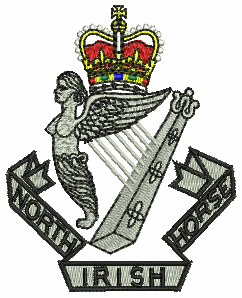North Irish Horse
| North Irish Horse | |
|---|---|

The badge of the North Irish Horse.
|
|
| Active | 1902–1946 1947–Present (as a Sqdn) |
| Country |
|
| Branch |
|
| Type | Yeomanry |
| Role | Formation Reconnaissance and Signals |
| Size | Two Squadrons |
| Part of | Royal Armoured Corps and Royal Signals |
| Garrison/HQ | Belfast |
| Nickname(s) | The Horse, The Millionaires Own |
| Motto(s) | Quis Separabit (Who shall separate us) (Latin) |
| March | |
| Anniversaries | Hitler Line, 24 May |
| Engagements | Somme, Ypres, Hitler Line, Iraq, Afghanistan |
| Commanders | |
| Honorary Colonel | Colonel Danny De B Kinahan |
| Insignia | |
| Tartan | Saffron (pipes) |
The North Irish Horse is a yeomanry unit of the British Territorial Army raised in the northern counties of Ireland in the aftermath of the Second Boer War. Raised and patronized by the nobility from its inception to the present day, it was one of the first non-regular units to be deployed to France and the Low Counties with the British Expeditionary Force in 1914 during World War I and fought with distinction both as mounted troops and later as a Cyclist Regiment, achieving 18 battle honours. The regiment was reduced to a single man in the inter war years and re-raised for World War II, when it achieved its greatest distinctions in the North African and Italian campaigns. Reduced again after the Cold War, the regiment's name still exists in B (North Irish Horse) Squadron, the Queen's Own Yeomanry and 69 (North Irish Horse) Signal Squadron (V), part of 32 Signal Regiment.
Under the plans for Army 2020, B (North Irish Horse) Squadron has come under command of the newly established Scottish and North Irish Yeomanry Regiment, while 69 (North Irish Horse) Signal Squadron has become 40 (NIH) Signal Squadron.
The raising of Militia units in Ireland commenced with the "Militia Act 1793", which in Ireland was used in conjunction with the compulsory disbandment of Lord Charlemont's Irish Volunteers, who had become a political entity and "out of the scope of official influence". The scope of the Militia was broadened by an act of the Dublin Parliament in 1796, which led to the raising of 49 troops of cavalry, later renamed yeomanry. A troop normally consisted of a captain, two lieutenants (commissioned by the Lord Lieutenant of Ireland) and forty men, along with a permanent sergeant and trumpeter. Troops were grouped together under the command of a regular army Brigade Major. The force was known collectively as the "Irish Yeomanry". Each man provided his own horse. The falling need for this force eventually led to its disbandment in 1834.
...
Wikipedia
